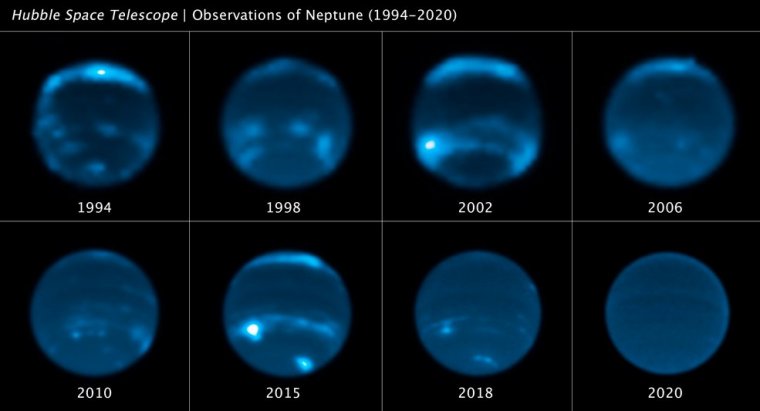| News / Space News |
Neptune's Disappearing Clouds Linked to the Solar Cycle
Astronomers have uncovered a link between Neptune's shifting cloud abundance and the 11-year solar cycle, in which the waxing and waning of the Sun's entangled magnetic fields drives solar activity.

This sequence of Hubble Space Telescope images chronicles the waxing and waning of the amount of cloud cover on Neptune. Photo: NASA, ESA, Erandi Chavez (UC Berkeley), Imke de Pater (UC Berkeley)
The link between Neptune and solar activity is surprising to planetary scientists because Neptune is our solar system's farthest major planet and receives sunlight with about 0.1% of the intensity Earth receives.
Yet Neptune's global cloudy weather seems to be driven by solar activity, and not the planet's four seasons, which each last approximately 40 years.
At present, the cloud coverage seen on Neptune is extremely low, with the exception of some clouds hovering over the giant planet's south pole.
A University of California (UC) Berkeley-led team of astronomers discovered that the abundance of clouds normally seen at the icy giant's mid-latitudes started to fade in 2019.
"I was surprised by how quickly clouds disappeared on Neptune," said Imke de Pater, emeritus professor of astronomy at UC Berkeley and senior author of the study. "We essentially saw cloud activity drop within a few months," she said.
The images reveal an intriguing pattern between seasonal changes in Neptune’s cloud cover and the solar cycle – the period when the Sun's magnetic field flips every 11 years as it becomes more tangled like a ball of yarn.
This is evident in the increasing number of sunspots and increasing solar flare activity.
As the cycle progresses, the Sun’s tempestuous behavior builds to a maximum, until the magnetic field beaks down and reverses polarity. Then the Sun settles back down to a minimum, only to start another cycle.
When it's stormy weather on the Sun, more intense ultraviolet (UV) radiation floods the solar system. The team found that two years after the solar cycle's peak, an increasing number of clouds appear on Neptune.
The team further found a positive correlation between the number of clouds and the ice giant's brightness from the sunlight reflecting off it.
"These remarkable data give us the strongest evidence yet that Neptune's cloud cover correlates with the Sun’s cycle," said de Pater.
"Our findings support the theory that the Sun's UV rays, when strong enough, may be triggering a photochemical reaction that produces Neptune’s clouds."
Scientists discovered the connection between the solar cycle and Neptune's cloudy weather pattern by looking at 2.5 cycles of cloud activity recorded over the 29-year span of Neptunian observations.
During this time, the planet's reflectivity increased in 2002 then dimmed in 2007. Neptune became bright again in 2015, then darkened in 2020 to the lowest level ever observed, which is when most of the clouds went away.
The changes in Neptune's brightness caused by the Sun appear to go up and down relatively in sync with the coming and going of clouds on the planet.
However there is a two-year time lag between the peak of the solar cycle and the abundance of clouds seen on Neptune.
The chemical changes are caused by photochemistry, which happens high in Neptune's upper atmosphere and takes time to form clouds. (NASA)
YOU MAY ALSO LIKE





